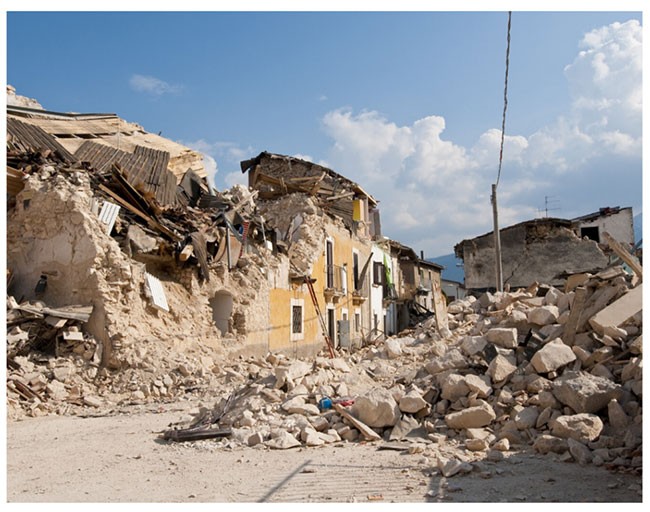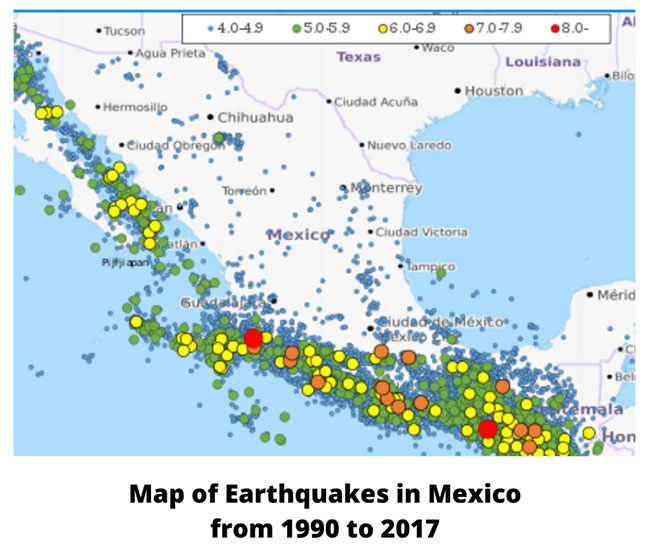Mexico is located on three large tectonic plates making one of the most earthquake-prone and seismologically active countries in the world. Earthquakes can happen any day of the year and can not be predicted. Thus, being an Expat Prepper in Mexico means learning a little bit about earthquake survival.
by Jolina Flowers, SHTF Blog’s Expat Prepper

In 1985, Mexico City was hit by a series of earthquakes. The foreshocks, aftershocks, and main earthquake caused somewhere between 5,000 and 45,000 deaths. Many bodies were never recovered. There were at least 50,000 injuries and another 100,000 people were left homeless. An estimated 420 buildings collapsed completely and another 3,124 buildings were seriously damaged.
In September 2017, another earthquake with a magnitude of 7.1 hit central Mexico. At least 370 people were killed and more than 6,000 injured. Twelve days earlier, an earthquake with a magnitude of 8.2 hit the Chiapas area, generating six-foot tsunami waves. At least 1,806 aftershocks of up to a magnitude of 6.1 occurred over the next few days. Approximately 1.5 million people were affected by the earthquake and more than 41,000 homes were damaged.
How Can You Prepare for a Mexico Earthquakes?
First, find out about the structural integrity of your home and the buildings you frequent. After the deadly earthquakes in Mexico City in 1985, the city began to require that all buildings be earthquake-proof. They began holding builders to a higher quality of material and construction. There is no doubt that these higher standards saved thousands of lives in 2017 when another major earthquake struck.
However, 3,000 buildings in the city collapsed or were severely damaged in the quake. People were trapped in those buildings and not everyone was rescued. Investigators have since discovered that corners were cut and documents falsified for some of these buildings. The substandard material that was used in many of those newer buildings was not able to withstand the earthquake and aftershocks.
Related: Challenges of Becoming an Expat Prepper
You might not get much information about the local grocery store, but you can have a professional examine the structural integrity of your home. Schools also must meet minimum standards, although you might not know how well the building will hold up until after the fact.

Next, examine the history of your location. The map above marks 22,370 earthquakes that have occurred in Mexico from 1990 to 2017. You can see how the epicenters are clustered along the coast in some areas. However, bear in mind that this map shows just the epicenters, where the earthquake originated. In some cases, the earthquake caused damage hundreds of miles away. Tsunamis are another peril caused by earthquakes to consider if you live along the coast.
Then, learn what to do in the event of an earthquake. Since the 1985 earthquake, Mexico City requires a city-wide earthquake drill every year on September 19, the anniversary of the 1985 quake and ironically the same day as the 2017 earthquake. During this drill, alarms sound over loudspeakers, alerts are broadcasted over the radio and TV stations, and messages are even sent to cellphones. The residents of Mexico City are encouraged to leave stores, workplaces and schools and head to designated safe areas.
Because of the way buildings are constructed in Mexico, it seems to be far better to leave a building than to seek refuge under a desk. Homes, schools, and places of employment are constructed of cement and rebar. Thus, if you survive the quake, you are still at risk of being crushed under the weight of the rubble.
So in the event of an earthquake, you should move to an open area where you are less likely to be hit by falling objects, such as buildings, trees or power lines. Stay away from bridges and keep alert for sinkholes.
You should also learn basic first aid. In Mexico, governmental organizations were slow or ineffectual in dealing with the thousands of people injured or trapped. The same will be true in the area of Mexico in which you live. It may take some time for official organizations to gather information and arrive on the scene after an earthquake.
Earthquake Preparedness Summary
Finally, do what you can to help as soon as you can. An earthquake is no time to go lone wolf and sit on your stockpile. The first 48 hours after an earthquake are crucial for search and rescue efforts. Having experienced a major earthquake, Mexican City residents wasted no time in creating bucket brigades to remove debris and search for survivors in 2017. The rescue workers dug through the rubble at a collapsed factory and saved 14 lives. They were volunteers determined to help loved ones trapped underneath.
With such poor infrastructure in Mexico, it’s very possible that relief will be a long time coming, if it happens at all. Your stockpile as an Expat Prepper can help alleviate hunger for men, women, and children who have lost everything in an earthquake. That doesn’t mean you need to impoverish yourself. However, your generosity will not be forgotten in the community.
If you don’t feel comfortable sharing your food stash, volunteering your expertise to assist in the search and rescue efforts is another way to help. If you aren’t strong enough to move rubble, offering food and water to rescue workers can be helpful. You could also open your home to displaced families after an earthquake without compromising your secret hoard location.
As you can see, preventative measures may help reduce the amount of damage to your home and protect your family. As an Expat Prepper in Mexico, you should create an emergency plan with your family and practice the plan. If an earthquake occurs, everyone knows where to go and what to do. Having an emergency medical kit and knowing how to administer basic first aid, like slow bleeding, dressing wounds, and setting broken bones, is certainly recommended. There are books you can include in your medical kit to assist as reference. Those books include Emergency War Surgery and the Department of the Army’s First Aid Manual.
